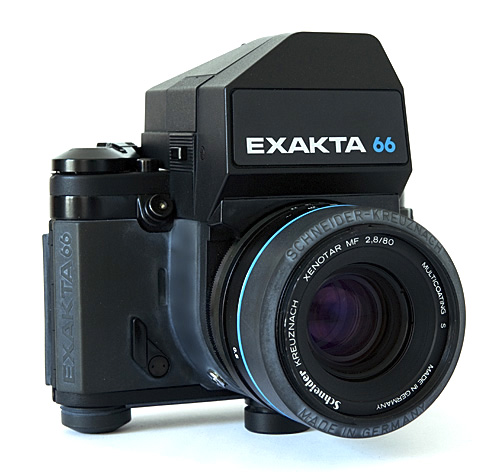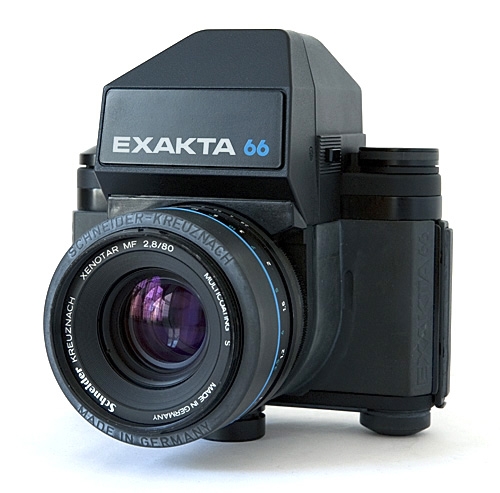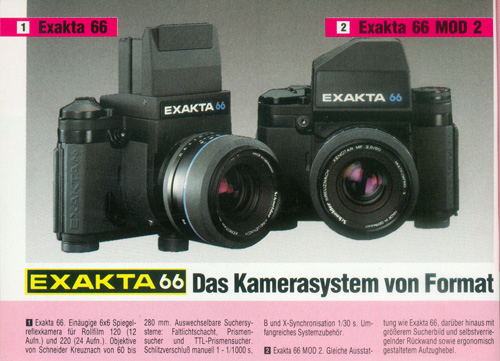by TRA
The History of the Pentacon Six
The Exakta 66 (1980s on)
Dates: 1984-1992 (?)
This camera was announced at Photokina in Cologne, West Germany in 1984, but appears not to have been available to buy until 1986. It remained in production until the year 2000, but with modifications for Mk II and Mk III versions in subsequent years (see next two pages).

[Mk I_1.jpg]
After more than 20 years of continuous use, this camera,
which was bought new in 1989, not surprisingly shows
some signs of
wear.
The Exakta 66 was based on a Pentacon Six chassis manufactured in Dresden, and used the glass from pentaprisms produced by Carl Zeiss Jena for the Pentacon Six.
Improvements/changes from the Pentacon Six were:
- A completely different cosmetic appearance, with a black finish and a thick rubber coating for most of the body, apparently inspired by the shock-resistant coverings applied at the time to binoculars designed for use by the military
- A metering prism with all-new electronic design, with LCD readouts within the prism and on its top surface outside
- Electrical contacts on the body to transfer shutter speeds to the metering pentaprism
- Lenses from Joseph Schneider of Bad Kreuznach in (then) West Germany that transmitted their aperture values to the metering prism
- An allegedly-improved two-position film pressure plate for 120 and 220 film
- A brighter (but smaller!) focussing screen
- A film-type reminder holder on the camera back.

[Mk I_2.jpg]
Note in both photographs the rectangular release buttons on each side of the metering prism.
The transfer of lens apertures and shutter speeds to the metering prism was a major advance that speeded up open-aperture metering enormously. Coupled with Schneider Kreuznach lenses of outstanding quality, the Exakta 66 offered a Medium Format camera with fast handling and the potential to produce images whose quality matched that of any other Medium Format camera on the market.
Some internet sources claim that the
metering prism was
only available with the Mk II version of the camera, but
this is incorrect.
The metering prism was not available until late in 1986,
possibly for Photokina
in the autumn, but the original version of the camera
(i.e., “Mk I”) was
in any case not generally available until earlier in the
same year.
I bought my first Exakta 66 new, together with a
metering prism, before
the Mk II version of the camera became available.
| This misunderstanding may have
arisen from the
illustration only in some of the
advertising for the camera in
later years – without paying attention
to the text. See
the illustration from 1990 to the right here,
which shows the original
Exakta 66 with a waist-level finder and the “Mod
2” version with the metering
prism. However, the text says:
My translation:
Claiming that the TTL prism was not available for the original version of the camera also does not take into account the change in the design of the release buttons on the metering prism, introduced only once the Mk II version of the camera was launched. For details of that version, see the next page. |

Information in “Internationaler Foto Katalog ’90”, page 52 The catalogue is dated April 1990 The same advertisement was still being run in the 1992 catalogue, at least. |
To go to the Bibliography, click here.
To go on to the next section, click
below.
27 The Exakta 66 Mk
II
To go to the beginning of the history section, click here.
To go to introduction to the cameras, click here.
To choose other options, click below.
Home
© TRA August 2010, revised August 2018
